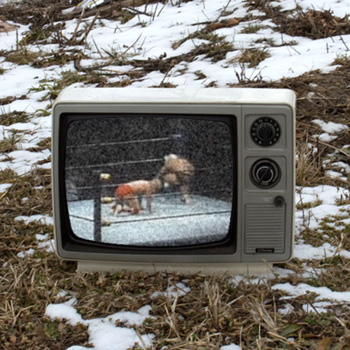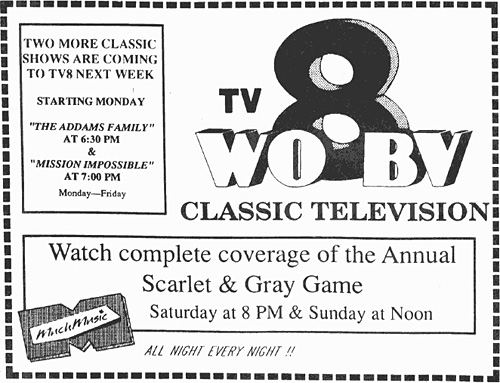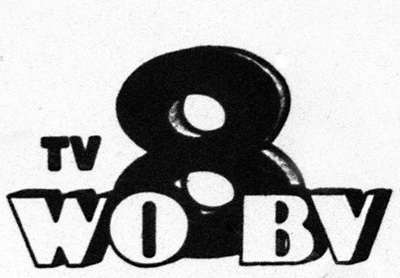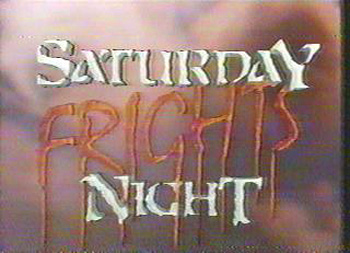CHANNEL 8, W08BV
“Eight looks great to me. It’s Columbus’ hot TV.” So went the jingle. Few saw Channel 8 during its 1985-91 existence but those who did remember it fondly. |
|
Channel 8, W08BV, was a low-power television station that operated from now long-gone studios at 2404 Old Olentangy River Rd (W. 3rd Ave. and Olentangy River Rd). The station’s 10-watt transmitter was atop the 34-story Borden Building at 180 E. Broad St. downtown. In theory, the station’s signal could reach 70% of Franklin County but, in practice, you could receive it in the University District, Victorian Village, the Short North, Grandview, and maybe the southernmost parts of Upper Arlington and even then it was pretty shaky sometimes. When Channel 8 went on the air on September 30, 1985, it was a different world than the one we know today. No Internet. Personal computers were primitive. Only 21% of homes had a VCR and offerings for the new device were limited. Only 41% of households had cable and there were just a handful of cable channels. For most folks, television in Columbus meant WCMH, Channel 4 (NBC); WTVN, Channel 6 (ABC); WBNS, Channel 10 (CBS); WOSU, Channel 34 (PBS); and the newcomer WTTE, Channel 28 (independent). Period. That was it. Nothing else. Any new station was welcome news. |
|
|
For much of its broadcast day, Channel 8 ran music videos. Initially, it was Hit Video USA, an MTV-like music video channel operated out of Houston, Texas. Later, Channel 8 began rebroadcasting Canada’s Much Music, the MTV of the Great White North. I really enjoyed Much Music. It was a little smarter, a little more mature, and a little less pop than MTV, and it was less urgently trying to sell you something every single minute. I enjoyed the Canadian flavor and getting exposed to north-of-the-border artists like Mitsou and Stompin’ Tom Connors. And veejay Erica Ehm was a babe. For broke-ass college kids who couldn’t afford cable and MTV, Channel 8’s music video programming was a joy. Weekday afternoons and evenings, the station showed classic 1960s comedies such as Batman, The Addams Family, Green Acres, Mr. Ed, and Get Smart and dramas like The Fugitive, Mission Impossible, Big Valley, Lost in Space, Night Gallery, and The Invaders. Nostalgic Generation X college students watched these shows addictively. There was a kids’ block airing in the afternoon, about the time school let out, with Yogi Bear, The Jetsons, and other vintage Hanna-Barbera cartoons. |
Friday night was given over to local sports. Fall and winter, the station sent crews out to live broadcast and do commentary on Columbus and suburban high school football and basketball games. They even gave out a "Player of the Week" award to the outstanding athlette in that week's game. In the spring and summer, the station broadcast Columbus recreation league baseball and Ohio State baseball. I seem to remember some Ohio State wrestling and Otterbein, Ohio Wesleyan, and Ohio University college sports airing on Saturday afternoons as well. Saturday afternoons, Channel 8 had pro wrestling. NWA wrestling. Dusty Rhodes. Ric Flair. Ivan and Nikita Koloff. Tully Blanchard. Wahoo McDaniel. The NWA show was what wrestling used to be like before the WWE’s slick, overproduced, hyper-steroidal spectacles took over. It was physical, brutal, small, and Southern. Some of the audience members looked like they had more surviving teeth than IQ points but it was great fun. There was NASCAR racing on Sunday afternoons and a couple motorsports and hunting and fishing programs too. |
 |
Actual title screen from Channel 8's Saturday Night Frights |
Before TCM was gleam in Ted Turner’s eye, Channel 8 ran tons of old movies. There was also a good selection of recent Hollywood pictures. The station had a deep library of films to show. Cult movies like Monty Python and the Holy Grail showed up occasionally. Some truly surprising stuff showed up as well. I first saw the anti-nuclear weapons documentary Atomic Café on Channel 8. Channel 8 had a hosted horror movie, Saturday Night Frights, on Saturday evenings. J. Geils Band’s title song from the 1985 motion picture Fright Night was the theme song. The premise was that the host, a sleazy lawyer, had inherited his uncle’s haunted mansion with a basement full of old horror movies. Host segments were spent dealing with the house’s troublesome inhabitants or fending off the colorfully odd neighbors who stopped by. The Saturday Night Frights movies were heavy on 1950s black-and-white monster pictures (It Conquered the World, The Astounding She Creature) and 1960s A.I.P. horrors (The Raven, Masque of the Red Death). Zontar, It’s Alive, Mars Needs Women, and Larry Buchanan’s other Z-grade Corman knock-offs surfaced frequently. Somehow, some 1970s drive-in movies got sprinkled into the mix. I remember watching Texas Chainsaw Massacre—uncut--on Channel 8. |
Sunday mornings were held down a bevy of strange local preachers who bought time (cheap) from the station for their religious broadcasts. It was a sea of lumpy, unattractive people in cheap polyester suits with bad hair screaming about Hell and the devil and what-was-wrong-with-the-kids-these-days. I can’t remember the names but I can remember some of the characters:
|
|
At a time when most of the TV world was exploiting Reagan Administration policies to flee their commitments to their communities, Channel 8 did the opposite. Broadcasting local high school and college athletics was one part of this. Another was the program Street Talk, which featured man-in-the-street interviews, mostly downtown but sometimes elsewhere around the city. Additionally, Channel 8 did live broadcasts of the July 4 Short North Doo Dah Parade, remotes from Comfest, and tailgate parties before Ohio State football games. I recall some coverage of local bands and musicians too. Channel 8 existed because its parent company was betting on it finding a larger audience (and more advertising revenue) than its tiny transmitter could get it. As cable systems were becoming a major part of American television, law and regulatory policy was evolving to keep up. The owners hoped that emerging “must-carry’ laws, which required cable operators to include local broadcasters on their systems, would also require them to carry local low-power stations. Channel 8’s owners were banking that they could use must-carry to get cable audiences for low-power station investment. |
 |
It didn’t happen. By March 1991, Howard Publications, the station's California-based owners, had exhausted their last bid to persuade or compel local cable provider Time Warner to carry the station. The company had sunk over $2 million in the station and was looking to cut its losses. W08BV was put up for sale at a deeply discounted price. On March 31, 1991, after airing a documentary of station highlights called “The Best of Channel 8,” the station went off the air. The license and equipment were bought by a group of religious broadcasters. |
|
 |
|




